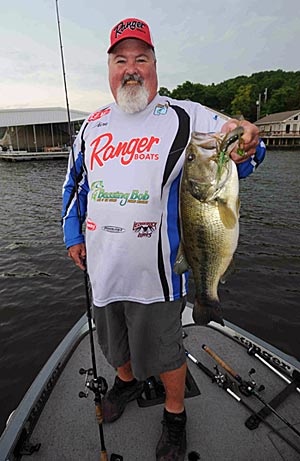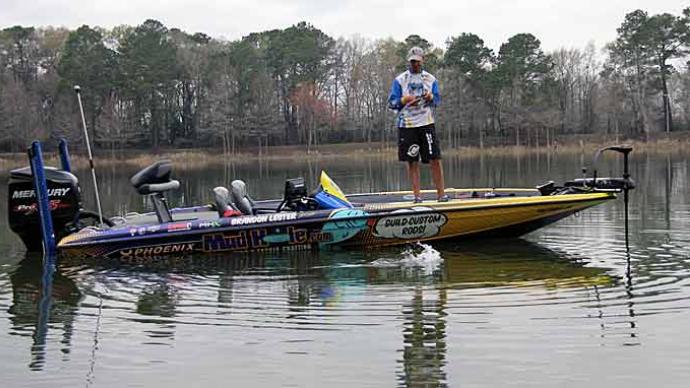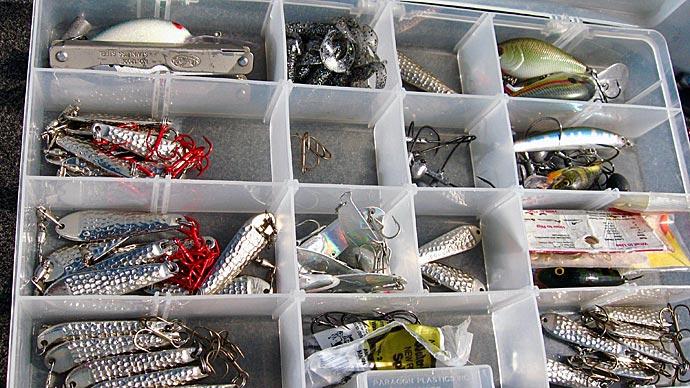
When the weather gets hot and sticky, Dion Hibdon checks the bass’ summertime menu to determine which lures to throw.
“The forage is always a big deal,” Hibdon says. “You have to be around the food.” The Missouri pro knows in his neck of the woods that shad and crayfish are the main staples of bass during the summertime, so he opts for lures that best imitate the forage.
Hibdon finds bass hugging the bottom during low-light conditions, so he selects crayfish-imitating lures. “As the sun comes up and the current gets to flowing a little bit, then I go to those shad-oriented baits,” Hibdon says.
Here are Hibdon’s five favorite lures for catching summertime bass from top to bottom.
Topwater popper
The former Bassmaster Classic and Forrest Wood Cup winner favors a topwater popper in open water when he sees bass suspended within 10 feet of the surface on his graph. He considers cloudy skies with a little chop on the surface ideal conditions for throwing the topwater popper.
“The bass are, so shad oriented that they will suspend up high in the water column,” Hibdon says. “When you see those fish on the graph within 10 feet or less of the surface, they are probably committed more to the surface than the bottom. So you can draw them to the top with a big topwater.” He believes those bass want an easy meal, and a sizeable topwater plug floundering on the surface imitates a dying shad.
If the weather is calm, Hibdon throws a Zara Spook and walks it across the surface. However, he often prefers making a lot of racket on the surface with the topwater popper. “I keep it moving pretty fast,” Hibdon says. “I want to draw them up to it. You need to make a lot of noise so I don’t throw a Spook–style bait.”
Swimbait
Hibdon favors this lure because he can work it effectively throughout all levels of the water column. “I can throw it out there and let it sink 5 or 6 feet and take off swimming, or let it go all the way to the bottom,” he says.
Scanning his depth finder gives Hibdon a clue on how deep to run his swimbait. “I try to make my cadence as such to where it covers that column of water,” he says. Most of the time, Hibdon works the lure in the bottom 10 feet of the water column by winding it for eight or ten turns of the reel handle and then letting it return to the bottom.

The tournament veteran believes the swimbait falls at the right speed through suspended fish, whereas a spoon or jig falls too fast. “You must work to keep a swimbait down near the bottom,” Hibdon says.
Gizzard shad is the primary forage for bass on the lakes Hibdon frequently fishes, so he tries to “match the hatch” with 5- or 6-inch swimbaits. He uses a 1/2-ounce swimbait jighead for working the lure slowly through the upper water columns but switches to a 3/4-ounce jighead for bass holding 15 to 18 feet deep.
Flutter Spoon
When he notices bass keep bumping or tapping his swimbait, Hibdon switches to a flutter spoon, which has an erratic action that triggers those fickle fish into biting. Most of the time, Hibdon selects a 1/2- or 5/8-ounce bait for his flutter spoon tactics.
Hibdon starts his flutter spoon presentation by letting the lure fall to the bottom. " I just kinda hop it up off the bottom, and then I follow it back down,” he says. “If you let it free fall back down, it gets to the bottom faster. But if you hop it up and kind of hold tension and follow it back down, it falls quite a bit slower.” Hibdon jerks the spoon about the length of his 7 1/2-foot rod, so he estimates the spoon hops 6 to 10 feet off the bottom on each jerk.
Plastic Worm
When all other lures fail to produce a bite for Hibdon, he can always catch summertime bass on a Texas-rigged plastic worm.
The Missouri angler favors a 10-inch worm most of the time, but he also throws 7- and 8-inch models. A ribbon-tail worm is his top choice because it has good swimming action.
The depth he fishes and the fish's mood determines the weight of the worm sinker Hibdon selects. “If the fish are aggressive and eating pretty good, then I will throw a heavier sinker (1/2 ounce) out there,” he says. “If the bite is slow, I have thrown a 3/16-ounce sinker in 20 feet of water.”
Hibdon drags the worm along the bottom until it bumps into something like a piece of wood or a rock. “If I bump something, I might hop it a little bit and try to entice a fish into eating it,” he says.
Jig
Hibdon relies on this lure to imitate crayfish when fishing rocky banks or bluegill when he targets shallow boat docks.
When targeting shallow bass around docks or boulders, Hibdon opts for a flipping or casting jig in lighter weights (3/8 ounce or less). He wants a more natural-looking fall for his lure, so Hibdon tips his jig with a Ledgerock Lures plastic craw that generates less action than curly-tail trailers.
If he finds bass hugging the bottom 20 feet deep, Hibdon chooses a 3/4-ounce football jig for probing the bottom. He will upgrade to a 1-ounce jig if a lot of current is flowing in his area. He wants his deep-water jig to produce a lot of swimming action, so Hibdon pairs it with a twin-tail plastic grub or a Strike King Rage Bug.
Hibdon lets the jig fall to the bottom and lifts and similarly drops his jig to his flutter spoon presentation. ”I will pull it up off the bottom until I feel like I got the fish’s attention,” he says.
BassResource may receive a portion of revenues if you make a purchase using a link above.




